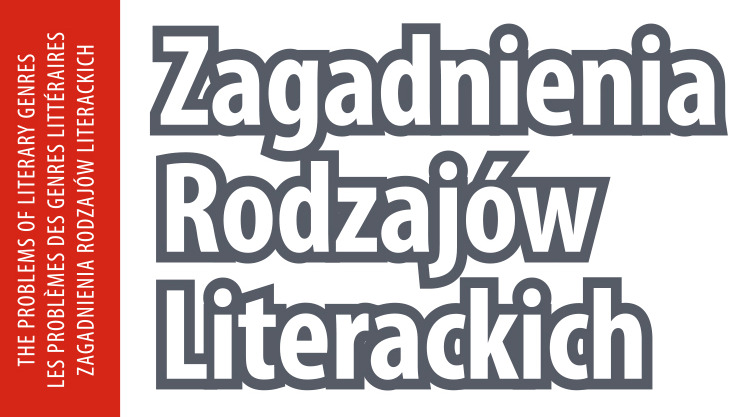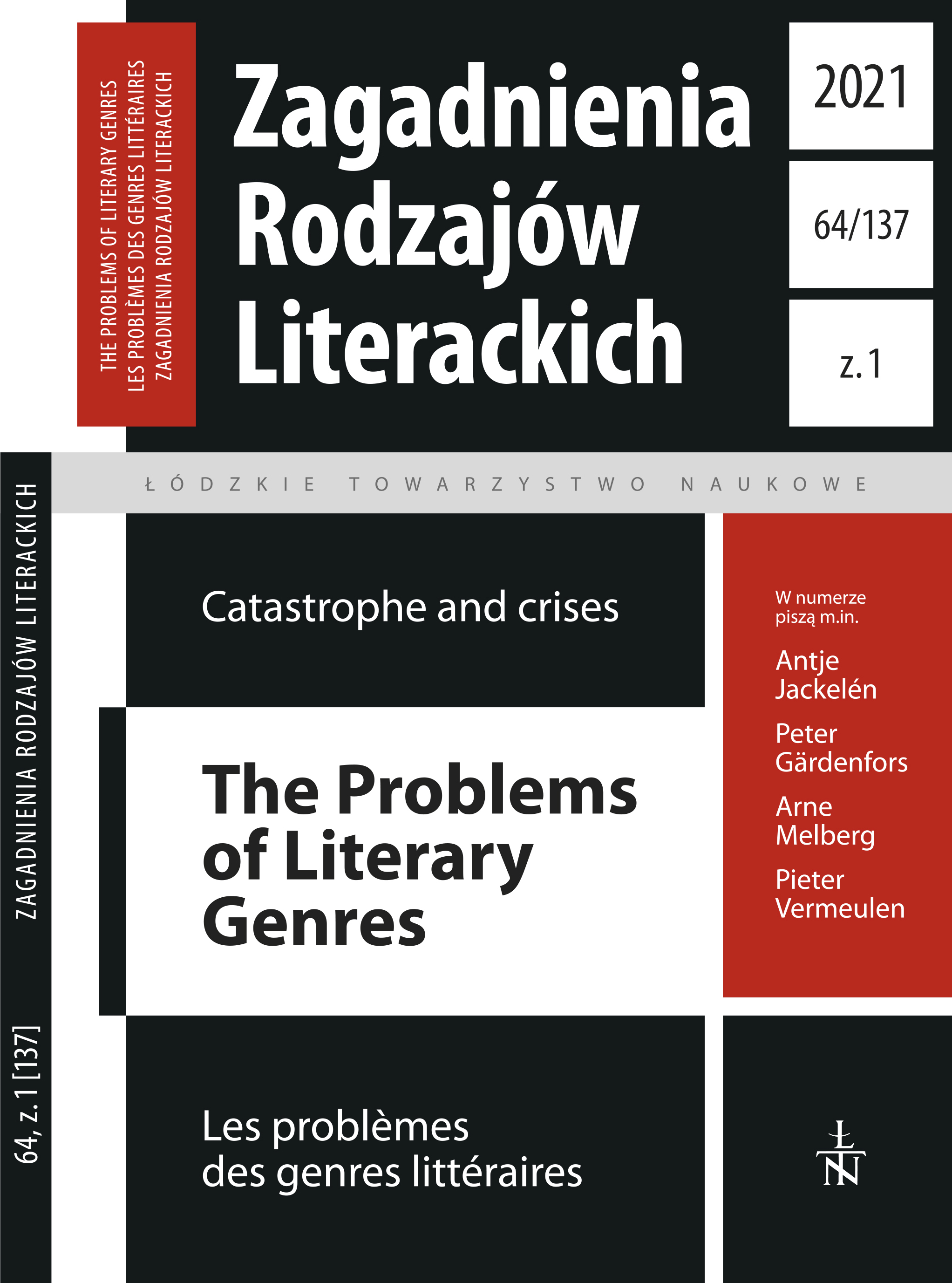Wyjść poza wyobrażony koncept natury. Rzecz o Piachu Urszuli Zajączkowskiej
DOI:
https://doi.org/10.26485/ZRL/2021/64.1/7Słowa kluczowe:
Zajączkowska Urszula, ecocriticism, ecopoetics, dark ecologyAbstrakt
The starting point of this article is an attempt to prove the authenticity of the essential catchword of Julia Fiedorczuk’s ecocriticis, that “with the environmental crisis comes a crisis of the imagination” (citation from Lawrence Buell). In this article, the concept of disaster functions in an ecocritical practice is analysed and how we can avert anthropocentric and deleterious ways of thinking. An important context here is Timothy Morton’s concept of ecomimesis texts and more ecological, ambient poetics, where text reflects real processes which depart from the concept of imaginary nature. Specifically, this paper proves that in the latest poetry volume written by Urszula Zajączkowska, using the example of the volume Piach (2020), that firstly, the anthropocentric view of nature (which underlines the concept of ecomimesis) is abandoned, which, the imagined and servant, is far removed from the actual processes existing in the world. Secondly, the analysis and interpretation of selected texts in the poems confirms that the poetry exhibits a special sensitivity to changes and processes. In turn, this enables us to comprehend the effects of human actions. For this reason, the reader can exercise and practice his imagination, which is helped by the auratic poetics used. These activities facilitate a better understanding of the effects of human activities. Urszula Zajączkowska poetry’s prompts us to imagine how the materiality of the world works in practise and how these tiny atoms created the whole world. Also, this poetry fosters a way of thinking that assumes particular significance in the context of ongoing climate change, without necessarily aspiring for the currently popular apocalyptic themes.
Liczba pobrań
Bibliografia
Barcz Anna (2016), Realizm ekologiczny. Od ekokrytyki do zookrytyki w literaturze polskiej, „Śląsk” Wydawnictwo Naukowe, Katowice.
Brennek Michał (2019), Czy pogoda pod psem?, „Przekrój”, nr 4(3567), s. 7.
Fiedorczuk Julia (2015), Cyborg w ogrodzie. Wprowadzenie do ekokrytyki, Wydawnictwo Naukowe Katedra, Gdańsk.
Fiedorczuk Julia, Beltrán Gerardo (2015), Ekopoetyka / Ecopoetica / Ecopoetics. Ekologiczna obrona poezji, Biblioteka Iberyjska, Warszawa.
Marzec Andrzej (2018), „Jesteśmy połączonym z sobą światem” — Timothy Morton i widmo innej wspolnoty, „Teksty Drugie”, nr 2, s. 88–101.
Morton Timothy (2009), Ecology without Nature. Rethinking environmental aesthetics, Harvard UP, Cambridge–Massachusetts–London.
Pieczek Urszula, Zajączkowska Urszula (2019), Umiejętność łatwego wybaczania [wywiad], „Znak”, www.miesiecznik.znak.com.pl/urszula-zajaczkowska-umiejetnosc-latwegowybaczania/ [dostęp: 23.02.2021].
Pluszka Adam, Zajączkowska Urszula (2017), Gdzieś tam jesteśmy. Rozmowa z Urszulą Zajączkowską, „Dwutygodnik”, www.dwutygodnik.com/artykul/7104-gdzies-tam-jestesmy.html [dostęp: 23.03.2021].
Szaj Patryk (2020), Po cienkim lodzie (Dahr Jamail: ‘Koniec lodu. Jak odnaleźć sens w byciu świadkiem katastrofy klimatycznej’), „ArtPapier”, nr 14(398), www.artpapier.com/index.php?page=artykul&wydanie=398&artykul=7976 [dostęp: 22.02.2021].
Szkłowski Wiktor (2006), Sztuka jako chwyt [w:] Teorie literatury XX wieku. Antologia, red. Burzyńska A., Markowski M.P., tłum. R. Łużny, Znak, Kraków, s. 95–111.
Szymborska Wisława (2014), Wystarczy / Enough, Wydawnictwo a5, Kraków.
Tabaszewska Justyna (2011), Zagrożenia czy możliwości? Ekokrytyka — rekonesans, „Teksty Drugie”, nr 3, s. 205–220.
Tabaszewska Justyna (2018), Ekokrytyczna (samo)świadomość, „Teksty Drugie”, nr 2, s. 7–16.
Tabaszewska Justyna (2019), Katastrofy afektywne. Kategoria katastrofy w dyskursie ekokrytycznym i afektywnym — wstępne rozpoznania [w:] Poetyki ekocydu. Historia, natura, konflikt, red. Ubertowska A., Korczyńska-Partyka D., Kuliś E., IBL, Olsztyn.
Ubertowska Aleksandra (2018), „Mowić w imieniu biotycznej wspolnoty”. Anatomie i teorie tekstu środowiskowego/ekologicznego, „Teksty Drugie”, nr 2, s. 17–40.
Wodecka Dorota, Zajączkowska Urszula (2020), Urszula Zajączkowska nagrodzona za esej „Patyki i badyle”. Mowi: „Wśrod roślin nie ma nienawiści”, „Wysokie Obcasy”, www.wysokieobcasy.pl/wysokie-obcasy/7,152731,25201327,urszula-zajaczkowska-uciekam-od-lilii-i-roz.html [dostęp: 24.02.2021].
Zajączkowska Urszula (2020), Piach, Wydawnictwo Warstwy, Wrocław.







